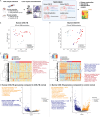MMPs and NETs are detrimental in CNS-tuberculosis with MMP Inhibition in CNS-tuberculosis mice improving survival
- PMID: 41076519
- PMCID: PMC12514826
- DOI: 10.1186/s12974-025-03548-7
MMPs and NETs are detrimental in CNS-tuberculosis with MMP Inhibition in CNS-tuberculosis mice improving survival
Abstract
Despite anti-tuberculous treatment (ATT), central nervous system tuberculosis (CNS-TB) still causes permanent neurological deficits and death. To identify prognostic factors, we profiled a prospective cohort of pediatric HIV-negative tuberculous meningitis (TBM) and non-TBM patients. We found significantly increased cerebrospinal fluid (CSF) matrix metalloproteinases (MMPs) and neutrophil extracellular traps (NETs) in TBM patients with neuroradiological abnormalities and poor outcomes. To dissect mechanisms, we used our existing CNS-TB murine model, which shows neutrophil-rich necrotizing pyogranulomas with MMP-9 and NETs colocalizing, as observed in human CNS-TB pathology. Spatial transcriptomic analysis of both human and murine CNS-TB demonstrates a highly-inflamed and neutrophil-rich microenvironment of inflammatory immune responses, extracellular matrix degradation and angiogenesis within CNS-TB granulomas. Murine CNS-TB treated with ATT and MMP inhibitors SB-3CT or doxycycline show significantly suppressed NETs with improved survival. MMP inhibition arms show attenuated inflammation and well-formed blood vessels within granulomas. Adjunctive doxycycline is highly promising to improve CNS-TB outcomes and survival.
Keywords: Central nervous system tuberculosis; Doxycycline; Host-directed therapy; Matrix metalloproteinases; Neutrophil extracellular trap.
© 2025. The Author(s).
Conflict of interest statement
Declaration. Ethics approval and consent to participate: The Domain Specific Review Board from National Healthcare Group Singapore (Reference: 2015/00067) approved the study. Anonymized human adult brain samples were used. All animal procedures were approved by the Institutional Animal Care and Use Committee of National University of Singapore under protocols R15-1068 and R21-0633, in accordance with national guidelines for the care and use of laboratory animals for scientific purposes. Consent for publication: Informed consent was received from all the patients including consent for publication. Competing interests: The authors declare no competing interests.
Figures






References
-
- Price NM, Farrar J, Tran TT, Nguyen TH, Tran TH, Friedland JS. Identification of a matrix-degrading phenotype in human tuberculosis in vitro and in vivo. J Immunol. 2001;166(6):4223–30. 10.4049/jimmunol.166.6.4223. Epub 2001/03/10. - PubMed
-
- Kalita J, Misra UK, Nair PP. Predictors of stroke and its significance in the outcome of tuberculous meningitis. J Stroke Cerebrovasc Dis. 2009;18(4):251–8. PubMed PMID: 19560677. - PubMed
MeSH terms
Substances
Grants and funding
- postgraduate scholarship/Yong Loo Lin School of Medicine, National University of Singapore
- NUSMed B2B Collaboration Grant/National University Health System
- Junior Research Award and Chan Heng Leong Education and Research Fund/National University Health System
- NUSMed B2B Collaboration Grant/National University Health System
- NUHSRO/2016/066/NPCseedfunding/01/National University Health System
- NCID Catalyst Grant and NCID Short Term Fellowship/National Centre for Infectious Diseases Singapore
- NUHSRO/2018/052/PDF/04/NUSMed Post-Doctoral Fellowship
- NUHSRO/2017/073/PDF/03/NUSMed Post-Doctoral Fellowship
- NUHSRO/2018/052/PDF/04/NUSMed Post-Doctoral Fellowship
- NUHSRO/2017/073/PDF/03/NUSMed Post-Doctoral Fellowship
- HRD-1202008 and HRD-1826745/National Science Foundation
- NMRC/TA/20nov-0025 and NMRC/OFLCG/21Jun-0013/National Medical Research Council
- NMRC/TA/0042/2015, CSAINV17nov014, CSAINV21nov-0003, CSASI24jul-0005/National Medical Research Council
LinkOut - more resources
Full Text Sources
Miscellaneous

